
The family Stylidiaceae is a taxon of dicotyledonous flowering plants. It consists of five genera with over 240 species, most of which are endemic to Australia and New Zealand. Members of Stylidiaceae are typically grass-like herbs or small shrubs and can be perennials or annuals. Most species are free standing or self-supporting, though a few can be climbing or scrambling.

Donatia is a genus of two cushion plant species in the family Stylidiaceae. The name commemorates Vitaliano Donati, an Italian botanist.

Andersonia is a subgenus of Stylidium that is characterized by a linear hypanthium, recurved mature capsule walls, an erect and persistent septum, and many seeds. This subgenus occurs in areas of tropical northern Australia and into Southeast Asia and was named in honour of William Anderson, the surgeon and naturalist who sailed with James Cook.

Stylidium section Debilia is a taxonomic rank under Stylidium subgenus Tolypangium. In his 1908 monograph on the family Stylidiaceae, Johannes Mildbraed had established this section as Debiles. In 1999, A.R. Bean published a taxonomic revision of several sections in subgenus Tolypangium in which he renamed the section from Debiles to Debilia.
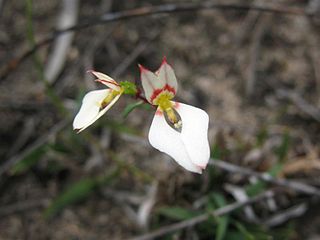
Levenhookia, also known as the styleworts, is a genus of ten recognized species in the family Stylidiaceae and is endemic to Australia. The genus is restricted to Western Australia almost exclusively with a few exceptions: L. pusilla's range extends into South Australia, L. dubia's range extends through South Australia into Victoria and New South Wales, L. sonderi is native only to Victoria, and L. chippendalei is also found in the Northern Territory.
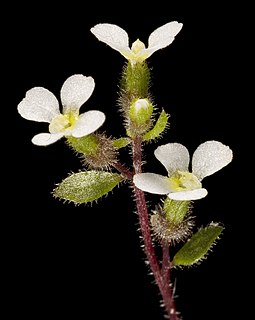
Levenhookia dubia, the hairy stylewort, is a dicotyledonous plant that belongs to the genus Levenhookia. It is an ephemeral annual that grows from 2–6 centimetres (0.79–2.36 in) tall with obovate leaves that are generally 2–5 millimetres (0.079–0.197 in) long. Flowers are white and bloom from September to October in its native range. L. dubia is most closely related to L. sonderi, which has been described as a variety of L. dubia in the past. It is endemic to Australia and has native ranges in Western Australia, South Australia, New South Wales, and Victoria. Its habitat has been reported as being sandy soils in granite outcrops.
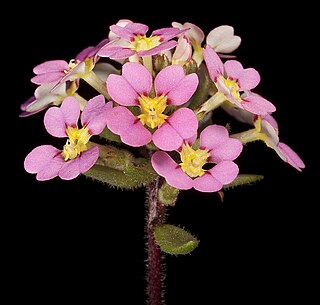
Levenhookia leptantha, the trumpet stylewort, is a dicotyledonous plant that belongs to the genus Levenhookia. It is an ephemeral annual that grows from 2–6 centimetres (0.79–2.36 in) tall with ovate to lanceolate leaves that are generally 2–5 millimetres (0.079–0.197 in) long. Flowers are pink and bloom from September to October in its native range. It is endemic to Western Australia. Its habitat has been reported as being sand or sandy clay soils in granite outcrops and winter-wet depressions.
Levenhookia octomaculata, the dotted stylewort or eight-spotted stylewort, is a dicotyledonous plant that belongs to the genus Levenhookia. The specific epithet octomaculata refers to the eight red dots this plant produces on each flower. It is an ephemeral annual that grows from 4–10 centimetres (1.6–3.9 in) tall with a simple or branched stem. There are very few leaves that are obovate to spathulate and mostly around the base of the stem. Scapes are umbellate and dark-coloured. Flowers are bright pink with white throats and two red dots borne on each petal. L. octomaculata blooms from September to October in its native range. It is endemic to Western Australia. Its habitat has been reported as being sandy soils in open Acacia acuminata or Eucalyptus wandoo forests in compact colonies. Because this species is known from several populations that are not believed to be under immediate threat but are poorly known, this species has been declared a priority three species, which means it is under consideration for rare status but more information must be gathered first.

Levenhookia pauciflora, the deceptive stylewort, is a dicotyledonous plant that belongs to the genus Levenhookia. It is an ephemeral annual that grows from 5–10 centimetres (2.0–3.9 in) tall with ovate to suborbicular leaves. Flowers are white and bloom from September to November in its native range. L. pauciflora is endemic to Western Australia where it grows in sandy soils in sandstone or granitic areas. The flowers of L. pauciflora resemble those of Stylidium ecorne and it has been said that S. ecorne mimics L. pauciflora to take advantage of its pollinators.

Levenhookia preissii, Preiss's stylewort, is a dicotyledonous plant that belongs to the genus Levenhookia.
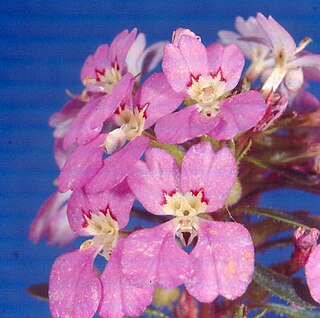
Levenhookia pulcherrima, the beautiful stylewort, is a dicotyledonous plant that belongs to the genus Levenhookia. It is an ephemeral annual that grows on average from 7–8 centimetres (2.8–3.1 in) tall. Lower leaves are spathulate while upper leaves are oblanceolate and up to 1.8 centimetres (0.71 in) long. Stems and older leaves are red. Flowers are pink to rose-coloured with the shorter anterior petals about 3 millimetres (0.12 in) long. The sensitive labellum is obovate and white with a circular grey-purple mark on either side of the terminal portion. Both leaves and stems of L. pulcherrima possess more glandular trichomes than in other Levenhookia species. When describing this new species, Sherwin Carlquist noted that it is most closely related to L. preissii and L. pauciflora, which might place it with those species in section Levenhookia, but Carlquist neglected to specifically say so. He also noted that several features of this species, including its corolla lobe, labellum, throat appendage, and stigma morphology, are distinctly different from those species with which it appears to be associated. L. pulcherrima is endemic to southwestern Western Australia.
Levenhookia pusilla, the midget stylewort or tiny stylewort, is a dicotyledonous plant that belongs to the genus Levenhookia. It is an ephemeral annual that grows about 5 to 6 cm tall with suborbicular to ovate-spathulate leaves. Flowers are pink to white and bloom from September to December in its native range. L. pusilla is endemic to southwestern Western Australia and South Australia where it grows in granitic or lateritic soils.
Levenhookia sonderi, the slender stylewort, is a dicotyledonous plant that belongs to the genus Levenhookia. It is an ephemeral annual that grows only in Victoria, Australia. L. sonderi is most closely related to L. dubia and it has even been described as a variety of L. dubia in the past. Johannes Mildbraed was the first person to reduce L. sonderi to a variety of L. dubia in his 1908 taxonomic monograph on the Stylidiaceae in which he noted he could not find any significant difference between L. sonderi and L. dubia to maintain the separate taxonomic treatment of the two species. Later studies have considered the species to be distinct.

Levenhookia stipitata, the common stylewort, is a dicotyledonous plant that belongs to the genus Levenhookia. It is an ephemeral annual that grows about 7–10 centimetres (2.8–3.9 in) tall with oblanceolate to linear leaves. Flowers are pink and bloom from August to January in its native range. L. stipitata is endemic to southwestern Western Australia where it grows in granitic or lateritic soils. This species was first described by George Bentham in 1837 as Stylidium stipitatum and was later reclassified into the genus Coleostylis, which was placed into synonymy with the genus Levenhookia.

Levenhookia sect. Coleostylis is a section of four recognized species in the family Stylidiaceae. It was established and described by Johannes Mildbraed in 1908 to separate the subgeneric taxonomy in the genus Levenhookia. Mildbraed originally placed L. preissii and L. stipitata in this section. L. chippendalei was described in 1966 and placed in this section by Rica Erickson and Jim Willis. Section Coleostylis could also contain L. octomaculata, which Erickson described in 1956, noting its affinities with L. stipitata but without placing it in a section. Otherwise it would be unplaced as to a section.
Levenhookia sect. Estipitatae is a section of two to three recognized species in the family Stylidiaceae. It was established and described by Johannes Mildbraed in 1908 to separate the subgeneric taxonomy in the genus Levenhookia. Mildbraed originally placed L. dubia and L. leptantha in this section. L. sonderi was described by Mildbraed as a variety of L. dubia, though other resources treat it as a distinct species.
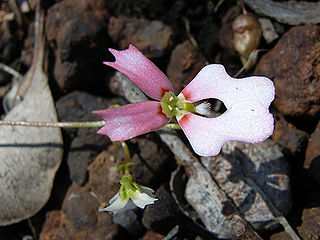
Stylidium subg. Centridium is a subgenus of Stylidium that is characterized by a globose hypanthium, a stipitate brush-like stigma, and gynostemium mobility not produced by a sensitive hinged torosus but by the movement of a cunabulum. All species with the possible and doubtful exception of S. weeliwolli are annuals. This subgenus appears to be most closely related to the genus Levenhookia, which suggests an ancestral relationship. Centridium was first published by John Lindley in the 1839 publication, A Sketch of the Vegetation of the Swan River Colony. Lindley created this subgenus to distinguish species which did not fit into either of the two other subgenera that had existed at the time. He initially placed Stylidium calcaratum, the newly described Stylidium androsaceum, and Stylidium stipitatum into subgenus Centridium. His description of S. androsaceum turned out to be synonymous with S. calcaratum and S. stipitatum is a synonym of Levenhookia stipitata.

Stylidium perpusillum, the tiny triggerplant, is a dicotyledonous plant that belongs to the genus Stylidium, that occurs in south west Western Australia.
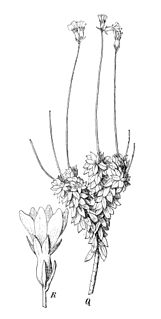
Forstera is a genus of small perennial plants in the Stylidiaceae family named in honour of the German naturalists Johann Reinhold Forster and his son, Georg Forster, who had previously described Forstera's sister genus, Phyllachne just five years earlier. It comprises five species that are endemic to New Zealand with the exception of F. bellidifolia, which is endemic to Tasmania. The species in this genus resemble those in a subgenus of the related genus Stylidium called Forsteropsis, but they are more closely related to the genus Phyllachne. Proposals to merge the two genera based on information from cladistic analysis have emerged because of these genera's morphological similarities and evidence that they are paraphyletic.

Stylidium affine is a species in the genus Stylidium that is endemic to Western Australia.














